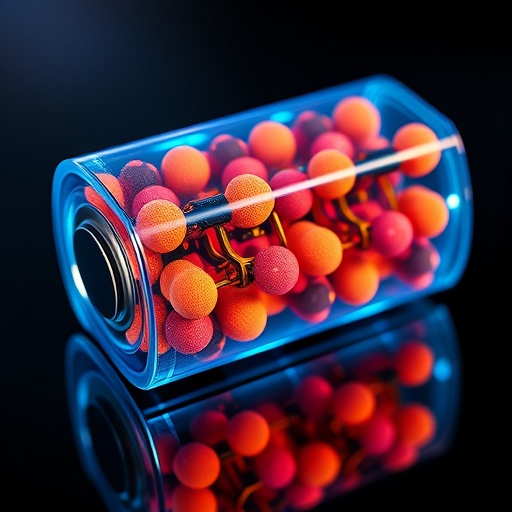In the relentless pursuit of next-generation energy storage solutions, lithium batteries remain a cornerstone of technological advancement. Recent innovations have steered towards polymer electrolytes coupled with lithium-rich manganese-based layered oxide (LRMO) cathodes, combined with anode-free cell designs to push the boundaries of energy density and safety. These systems promise transformative impacts, offering higher energy densities while mitigating safety risks inherent in conventional lithium-ion batteries. However, challenges arise from unstable anode morphologies and complex interfacial chemistry, particularly at the electrolyte-cathode boundary, where oxygen escape and polymer electrolyte decomposition can derail battery longevity.
At the crux of these challenges lies the vulnerability of the electrolyte-cathode interface. Irreversible anionic reactions provoke oxygen release from the LRMO cathode, catalyzing polymer electrolyte degradation that triggers severe interfacial deterioration. This degradation undermines cycling stability, a crucial metric for practical battery applications. Addressing these issues necessitates a fundamental rethink of electrolyte chemistry to achieve both high-performance energy storage and long-term operational resilience. Recent research breakthroughs have yielded an innovative approach that redefines polymer electrolyte design with an unprecedented molecular strategy.
The breakthrough centers on tailoring the polymer electrolyte’s solvation structure by integrating fluoropolyether backbones that combine strongly solvating polyether segments with weakly solvating fluorohydrocarbon pendants. This clever molecular architecture fosters an anion-rich solvation shell around the lithium ions within the electrolyte. The anion-rich environment critically influences the formation of fluorine-rich interphases on both the cathode and anode surfaces. These fluorine-dense interfacial layers act as formidable barriers, effectively suppressing parasitic reactions that would otherwise degrade the electrodes.
This dual-action design addresses two notorious problems simultaneously: it stabilizes the LRMO cathode by significantly curbing oxygen redox irreversibility and it suppresses electrolyte decomposition at the anode interface. The cathode benefits from a dramatic reduction in oxygen evolution, which historically has led to oxygen escape and compromised electrode structure. The electrolyte’s robust fluorine interface mitigates catalytic attack on polymer chains, thwarting degradation pathways that undermine battery lifespan.
A notable aspect of this electrolyte innovation lies in its incorporation of 30 wt% trimethyl phosphate (TMP), a component that enhances the overall stability and electrochemical performance without sacrificing ionic conductivity. This quasi-solid-state electrolyte configuration enables exceptionally high areal capacities exceeding 8 mAh cm⁻² in LRMO-based pouch cells, a significant milestone in the quest for realistic, scalable lithium battery technologies. Furthermore, coin cells equipped with this electrolyte exhibit extraordinary cycling stability, maintaining functionality beyond 500 cycles at ambient temperature (25°C).
The practical implications are profound. The pouch cell prototypes demonstrate an energy density of 604 Wh kg⁻¹, standing among the highest reported for polymer electrolyte systems incorporating LRMO cathodes. Even more impressive is the volumetric energy density reaching 1,027 Wh L⁻¹, underscoring the volumetric efficiency critical to portable and electric vehicle applications. These cells also exhibit exceptional safety characteristics, enduring severe abuse tests such as nail penetration while remaining fully charged, a scenario that typically triggers catastrophic failure in conventional lithium batteries.
Such resilience stems from the unique chemistry of the electrolyte’s solvation and the resultant formation of fluorine-rich interfacial layers, showcasing the interplay between molecular design and macroscopic performance improvements. The anion-derived interphases confer robustness, effectively isolating electrodes from harmful reactions and stabilizing the electrode structures throughout extensive cycling periods.
The implications of this work transcend incremental improvements. It points to a paradigm where electrolyte chemistry is not merely a passive ionic conductor but an active participant in stabilizing electrode surfaces and enhancing battery safety. This approach could serve as a blueprint for future development of solid and quasi-solid-state electrolytes tailored for high-energy, high-safety lithium battery systems.
From an industrial perspective, the availability of a polymer electrolyte capable of sustaining thick LRMO cathodes at high areal loadings paves the way for commercial-scale batteries with heightened energy metrics. This innovation aligns with the broader push towards sustainable energy technologies, facilitating longer-range electric vehicles and more dependable energy storage for grid applications alike.
Moreover, the integration of fluoropolyether-based electrolytes may inaugurate new research avenues exploring the fine balance between electrolyte solvation dynamics and interfacial chemistry. Understanding how weakly solvating fluorocarbon groups modulate anion coordination and interphase composition could enable further optimization, pushing energy densities even higher while safeguarding safety protocols.
Consequently, the demonstration of over 500 stable cycles with high areal capacity and outstanding safety in practical pouch cells marks a critical transition from laboratory curiosity to feasible technology. It signals a maturing of lithium battery technology, poised to meet the escalating demands of modern electronics, electric transport, and renewable energy sectors.
In conclusion, this pioneering work on fluoropolyether-based polymer electrolytes introduces a compelling route for harmonizing energy density, cycle life, and safety in lithium metal batteries. By architecting tailored solvation structures and leveraging anion-derived fluorine-rich interfacial layers, researchers have surmounted longstanding challenges that limited the potential of LRMO cathode systems. As this innovation advances towards commercialization, it heralds an era of safer, higher performing lithium batteries, integral to powering a sustainable, electrified future.
Subject of Research: Polymer electrolyte design and lithium-rich manganese-based layered oxide cathode stabilization for high-energy-density, safe lithium metal batteries.
Article Title: Tailoring polymer electrolyte solvation for 600 Wh kg⁻¹ lithium batteries.
Article References:
Huang, XY., Zhao, CZ., Kong, WJ. et al. Tailoring polymer electrolyte solvation for 600 Wh kg⁻¹ lithium batteries. Nature (2025). https://doi.org/10.1038/s41586-025-09565-z
Image Credits: AI Generated




